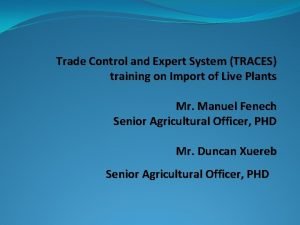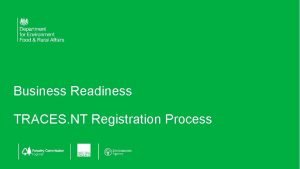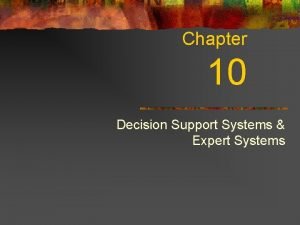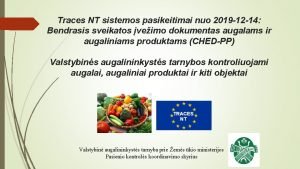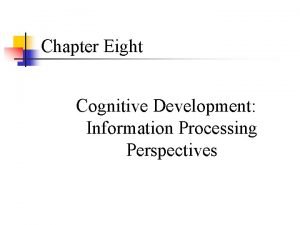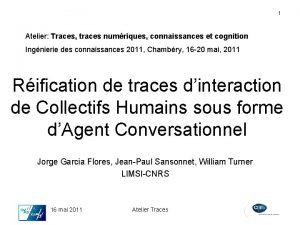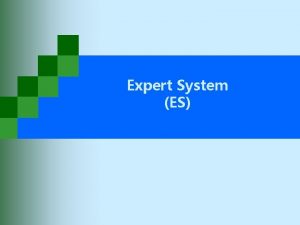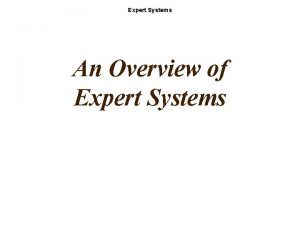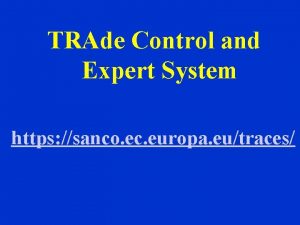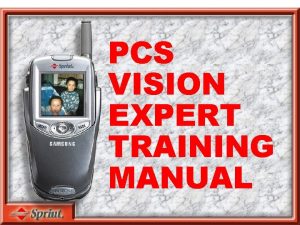Trade Control and Expert System TRACES training on
















- Slides: 16

Trade Control and Expert System (TRACES) training on Import of Live Plants Mr. Manuel Fenech Senior Agricultural Officer, PHD Mr. Duncan Xuereb Senior Agricultural Officer, PHD

TRACES: What is it? � TRACES =Trade Control and Expert System � It is a web-based veterinarian certification tool used by the European Union for controlling the import and export of live animals and animal products within and without its borders. � It is also used now for import checks of products of non-animal origin and live plants.

TRACES: What is it? � Its network falls under the responsibility of the European Commission: Directorate General for Health and Food Safety (DG SANTE) �Workflow between private and public �Centralized system �Multilingualism (23 EU official languages) � Statistics automation


TRACES: Main characteristics Policy Areas: Products: Animal Health Semen, ova and embryos Animal Welfare (EU exclusive) Products of animal origin Veterinary Public Health Products of non-animal origin Plant Health Live plants

TRACES: Main characteristics �Functionalities; Certification (INTRA, IMPORT, CVED, CED, EXPORT, DOCOM, DECLAR, CHEDPP) � Notification= Exchange of information. Notification of the arrival of a consignment to the BIP. �Exchange of information between competent authorities of EU Member States �Threat to plant health: Link with Europhyt. �Control registration � Availability to EU Member states and to Non-EU countries (Voluntary)


TRACES: Some history… �Sanitary crisis ; Classical Swine Fever 1997 � Main objective To improve traceability �Started on 1 st April 2004 (pilot phase) �A few countries joined TRACES at this phase. �Since 1/01/2005 mandatory for all BIPs and LVUs (animals and products of animal origin) �Since 2011, it can be used for products of non animal origin �Since 2013, it can be used for live plants

TRACES: Legal basis �Commission Decision 2003/24/EC: development of an integrated computerised veterinary system �Commission Decision 2003/623/EC: development of an integrated computerised veterinary system known as TRACES �Commission Decision 2004/292/EC: introduction of the TRACES system and amendment of Decision 92/486/EEC

Decision 2004/292/EC (1 st April 2004) �CVED for animals entering a EU MS and going to another MS. CVED for ALL animals entering the European Community �In accordance with Decision 2005/123/EC: (30 June 2005) �CVED for all rejected consignments �CVED for products subject to the following specific procedures under Directive 97/78/EC:

TRACES: Pilot project for Plant Health �Starting point: COPH’s meeting in Warsaw 7/10/2011 �Object: Border control of the introduction of plants and reproductive material �MS: AT, BG, BE, DE, EL, ES, FI, FR, HU, LT, LV, MT, NL, PL, RO, SE, UK and HR �First CHED-PP: Latvia May 2013; Poland June 2013; Lithuania August 2013; France September 2013, Malta February 2014, Spain April 2014 and Estonia June 2014, Switzerland December 2014 �CHEDPP Definition: panel working group 13/01/2012 �TRACES module: Version 6 April 2013

CHED-PP implementation

TRACES: Advantages �Standard application of laws and procedures �Speed up of BIP administrative procedures �Cooperation between services �Increase in security and speed of data transmission �Work simplification of official services

TRACES: Benefits for the sector �Improvement of the traceability of animals, products and plants movements for a better management of outbreaks �Improvement of information for more targeted controls �Deletion of language discrepancies �Interoperability between different Directorates General �Traceability of the movements of goods from the exporting countries until the final destination

TRACES: Benefits for national MS administrations �Access to all the information �Assistance during the decision making process �More statistics (DWH) �Interoperability between different services �Improvement of security within the transmission of data �Money saving through centralized updating of all legal information and dispatch of the certificate in all EU official languages

TRACES: Advantages
 How many countries are rigexpert products exported in?
How many countries are rigexpert products exported in? Traces nt training
Traces nt training Difference between dss and expert system
Difference between dss and expert system Decision categories
Decision categories Trade diversion and trade creation
Trade diversion and trade creation Umich
Umich Which is the most enduring free trade area in the world?
Which is the most enduring free trade area in the world? Trade diversion and trade creation
Trade diversion and trade creation Liner shipping and tramp shipping
Liner shipping and tramp shipping Expert system in dss
Expert system in dss The trade in the trade-to-gdp ratio
The trade in the trade-to-gdp ratio Fair trade not free trade
Fair trade not free trade Ted talk atlantic slave trade
Ted talk atlantic slave trade Traces nt sistema
Traces nt sistema Fuzzy traces
Fuzzy traces Information processing theory by atkinson and shiffrin
Information processing theory by atkinson and shiffrin The pedigree below traces the inheritance of alkaptonuria
The pedigree below traces the inheritance of alkaptonuria
